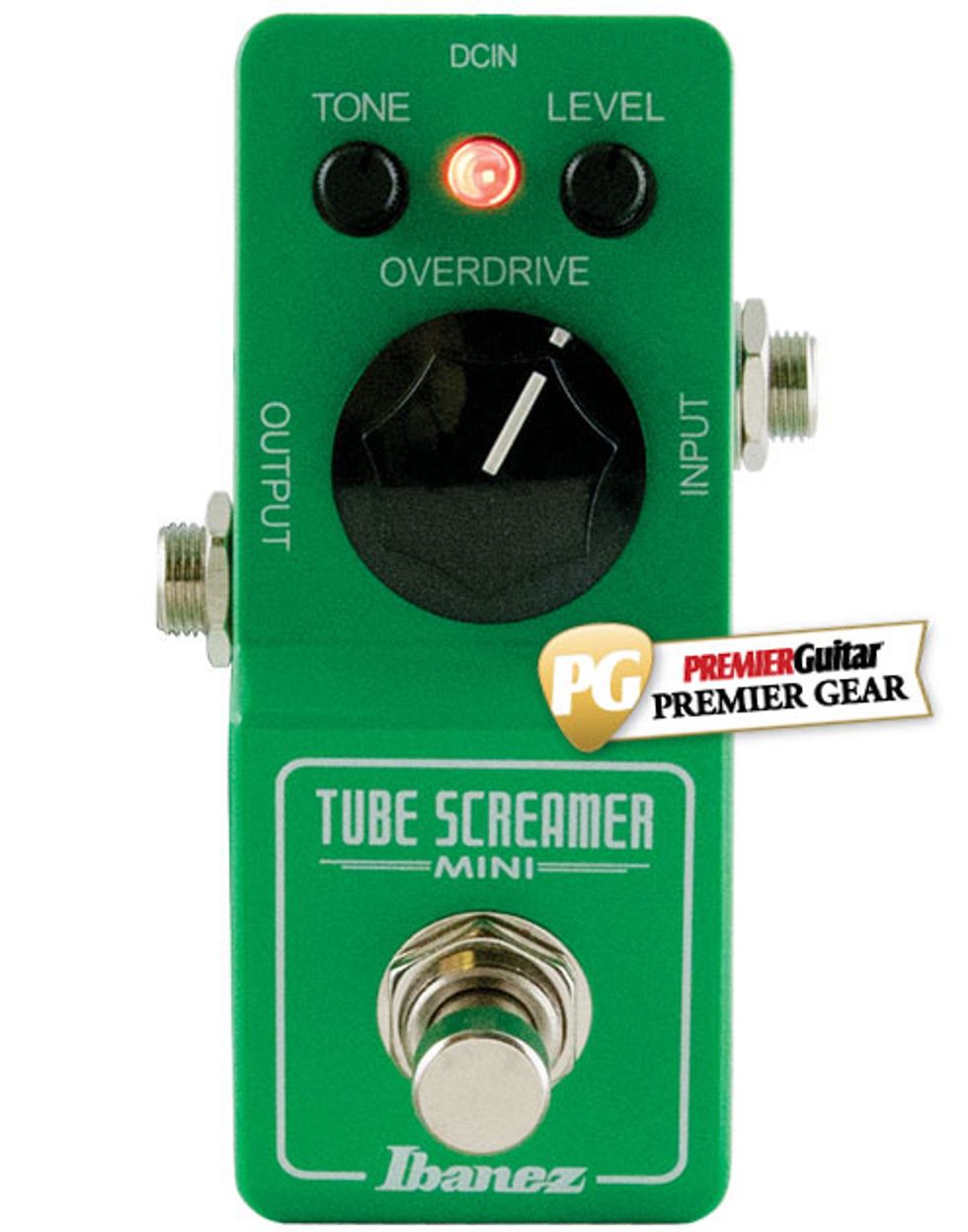
It’s hard to imagine an age B.T.S. (Before Tube Screamer.) True, there were fuzzes and distortions, many of which could reasonably function as overdrives. But the Ibanez TS family changed the very meaning of the term overdrive, spawning legions of low- to mid-gain imitators. Both boutique builders and large manufacturers (including Ibanez) based an industry on alleged TS improvements. But to many in the “if it ain’t broke, don’t fix it” camp, the classic Tube Screamer is still “the one.” For these purists, Ibanez’s latest creation, the Tube Screamer Mini, may be the only Tube Screamer that represents an actual improvement—not in sound or functionality, but in size. It’s a mere is 3.5" long and less than 1.5" wide.
Made in Japan, the Tube Screamer Mini is driven in part by the JRC4558 IC chip found in original TS-9s. The Mini’s controls are crammed into a green enclosure decked out with TS-808-style graphics. There’s a button-style footswitch, one big knob for drive, and two smaller knobs for tone and level. The small format means there’s no room for a 9V battery—you must us an AC adapter. (Given how many players rig their pedalboards with daisy-chained power supplies, this shouldn’t be a problem, unless you have an Eric Johnson-like fixation with battery types.)
Ratings
Pros:
Extremely compact. Classic TS tone. Great picking sensitivity. Organic feel.
Cons:
None.
Tones:
Ease of Use:
Build/Design:
Value:
Street:
$79
Ibanez Tube Screamer Mini
ibanez.com
Test Tube Twins
I tested the Tube Screamer Mini with an Ernie Ball/Music Man Axis Sport and a Mexican Fender Strat, both played through a Fender ’63 Vibroverb reissue. I also pulled out a vintage Tube Screamer to compare, setting the knobs on both pedals to the same spots: tone and overdrive around 1 o’clock, and level around 11 o’clock. At first it seemed as though the Mini had a bit more gain than the original, but when I advanced the bigger box’s drive knob a hair, I got near-identical sounds.
Authenticity tests out of the way, I enjoyed putting the little TS to work in real-world jamming situations. With overdrive set to 3 o’clock, tone at noon, and volume around 1 o’clock, I got a rich, creamy sound perfect for flashy blues licks and double-stop rhythm figures. Even with the gain up high, the Mini was incredibly responsive to dynamics. I could get a relatively clean sound on harmonically dense chords by using a gentle thumbpicking approach, while strong pick attack and power chords generated heavy crunch.
Keeping the same tone and volume settings but setting the drive to nearly nil, I got a thick boost that added body and just a hint of grit, lending my “clean” tone an exciting, multidimensional feel. The signature midrange emphasis of the Tube Screamer circuitry remained in this near-clean setting, adding presence and sustain. And what’s better than one TS? Try using the Mini as a clean boost to overdrive another Tube Screamer. If you like lively, midrange-heavy lead tones that can rise above a noisy band, you’ll love this setup.
The Verdict
There’s a reason the Tube Screamer is among the most popular pedals of all time—it’s a sort of tonal Swiss Army knife. It can function as an overdrive/boost, or add presence to an already hot signal. While the Mini is small enough to fit into a shirt pocket, don't be fooled—it’s 100-percent Tube Screamer. Even if you already own a Tube Screamer or TS-variant, there’s no reason not to pick up a Mini. With its broad range of great sounds, portable size, and attractive price, it can expand your tone palette in myriad ways—on the cheap, and without taking up much room.















![Rig Rundown: Russian Circles’ Mike Sullivan [2025]](https://www.premierguitar.com/media-library/youtube.jpg?id=62303631&width=1245&height=700&quality=70&coordinates=0%2C0%2C0%2C0)









